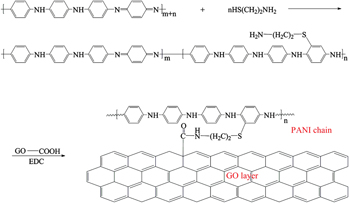Article contents
Covalent attachment of functionalized polyaniline nanofibers onto graphene oxide
Published online by Cambridge University Press: 03 September 2012
Abstract

The covalent attachment of cysteamine-functionalized polyaniline (PANI–NH2) nanofibers onto graphene oxide (GO) sheets in an aqueous medium is investigated for the first time. The functionalized PANI is covalently attached onto the GO surface by simple amidation in the presence of 1-(3-dimethylaminopropyl)-3-ethylcarbodiimide. The technique can be conveniently scaled up for bulk production. The hybrid nanomaterial is easily synthesized, has good thermal stability, and disperses well in a solvent. Characterization techniques (Fourier transform infrared spectroscopy, thermogravimetry analysis, field emission scanning electron microscopy, and transmission electron microscopy) indicate the successful binding of the functionalized PANI nanofibers onto GO.
- Type
- Articles
- Information
- Copyright
- Copyright © Materials Research Society 2012
References
REFERENCES
- 6
- Cited by


